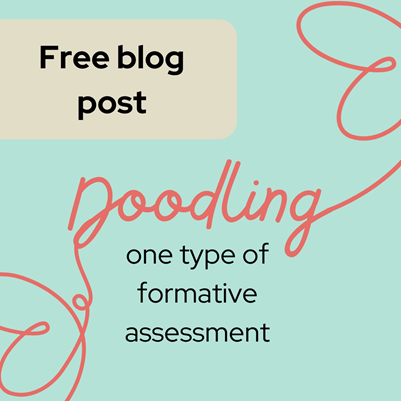Doodling - one type of formative assessment
A free professional blog to support English teachers

Following on from our last blog on the traffic light system (if you haven’t read it you will find it here), we would like to talk about another way to assess your student's understanding of a subject. Formative assessments, when done at the right time can give you a real insight into what your students do and don’t understand about a subject.
This week we will explore:
- What is formative assessment?
- Doodling - one type of formative assessment
- How to bring doodle notes and formative assessment into your classroom.
What is formative assessment?
You may have heard the term formative assessment before but what does it actually mean? There are a couple of ways to monitor your students’ learning and understanding of a subject and one of those ways is through formative assessment takes place during the learning process and provides ongoing feedback between the student and the teacher, allowing both to see where they need to improve.
Formative assessments allow the students to identify their strengths and weaknesses and at the same time help the teacher to understand where their students may be struggling and in need of extra help.
Doodling (Draw what you have learnt) - One type of formative assessment
One type of formative assessment we really like to use is doodling. This is where you ask your students to draw what they have learned. Drawing has huge benefits when it comes to learning and bringing it into your lessons can allow your students to process what they have learned in a new way.
Remember that all learners are different, some of your students will be visual learners, asking these students, especially, to draw what they have learned helps them to process and take new understanding from the lesson.
How to bring doodle notes and formative assessment into your classroom
Students do not need to be good at drawing to get something from this type of formative assessment but it may be necessary to ease their anxiety around the process.
It is a great practice to model this type of drawing assessment, to show your students what is expected. Describe your own thought process, something like “I want to show how the elements are linked so I have drawn a chain.”
Set aside time at the end of the lesson to ask your students to prepare their drawings. Take time to explain clearly what you are trying to achieve with this type of assessment but be careful to keep the pressure low. A formative assessment is not a graded assessment, the aim is to help you understand how to help your students better.
For more information on formative assessments and how to incorporate drawing into your lessons read our hand-picked resource here from Edutopia.
Read more blog posts from The English Classroom here and be sure to sign up for our English teaching resources here. We will also send blog posts direct to your email.
Written by Rebecca Sparling